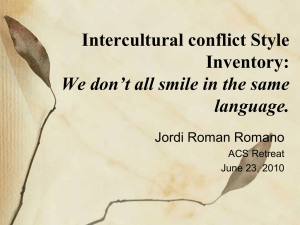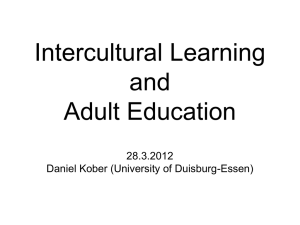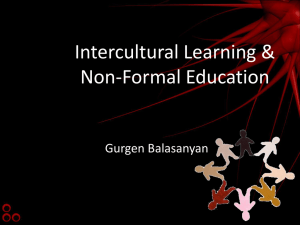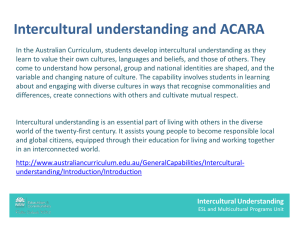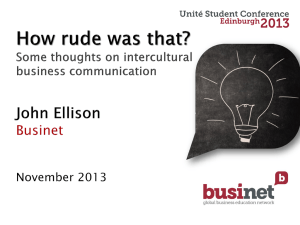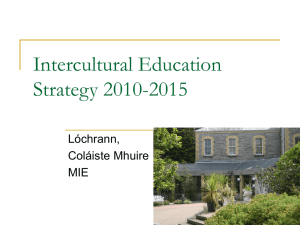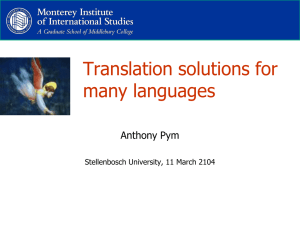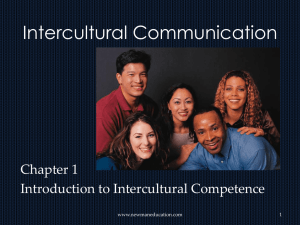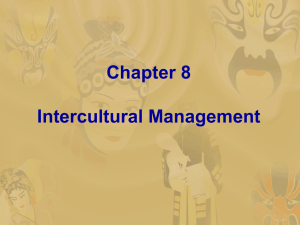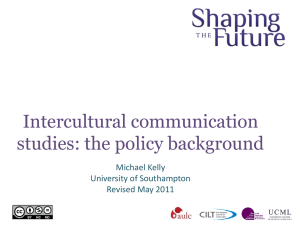PowerPoint - Academic Leadership
advertisement
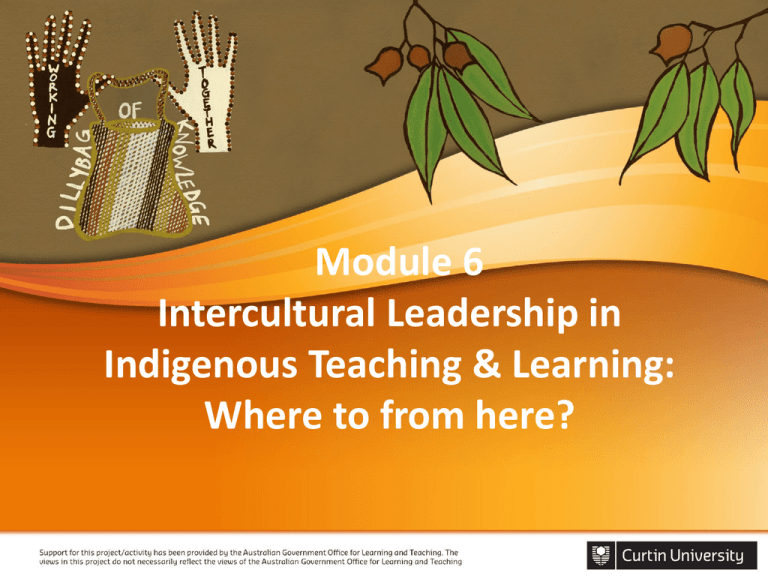
Module 6 Intercultural Leadership in Indigenous Teaching & Learning: Where to from here? Plan • • • • • Welcome Summary of modules 1-5 Panel and questions Intercultural leadership Community of practice Modules • Module 1: Introduction to intercultural (I/C) teaching & learning leadership • Module 2: Mindfulness in the classroom • Module 3: I/C skills to facilitate learning • Module 4: Professional skills for I/C leadership • Module 5: Relationship & personal skills for I/C leadership • Module 6: Summary and where to from here Linking with Higher Education Initiatives PREPARING FOR THE PANEL What do we want to ask? Intercultural space Homi Bhaba (1990, 1994) • cultural diversity • challenges idea of ‘cultural purity’ • the ‘third space’: – – – – – a space in-between cultures avoids binary oppositions shared space ‘hybridity’ allows and holds difference, is sometimes confronting, ambiguous, uncertain and risky – space of struggle yet deep potential Intercultural space Dudgeon & Fielder (2006) • Indigenous Australian programs in universities – cultural renaissance – decolonisation framework centred on Indigenous knowledge and experience – ‘third space’ – ‘strategic essentialism’ (Spivac) – use of binary oppositions as a strategic response to colonialism Intercultural space Nakata et al (2012) • binary oppositions: introductory level • cautions against creating ongoing binary oppositions • healthy rigorous debate in the intercultural space or ‘middle ground’ • deeper theoretical critique of Western & Indigenous knowledge systems Intercultural leadership qualities • Critical self-reflection – inter-cultural positioning – limits of our own knowledge – what is obscured and unarticulated – limits of thinking on both sides – blind spots? (Nakata et al 2012) Intercultural leadership qualities • Capacity to: – facilitate open, exploratory & creative inquiry in the intersections between cultures (middle ground) – to create a space that invites and holds difference – create a space that is inclusive and expansive – guide and facilitate dialogue & discussion so students engage and avoid ‘fence sitting’ (Nakata et al 2012) Intercultural leadership qualities • build tools & language and resources to help students engage in this space • withstand the tension • come up for air • re-engage with the intercultural space • courage (Nakata et al 2012) It is the third week of semester and you are discussing with your students the concept of cultural security in health services and the impacts of social determinants on Indigenous health and wellbeing. A bright, articulate male student starts to squirm noticeably in his chair. He is mumbling under his voice and you ask him if he would like to share his thoughts with the rest of the class. He responds, with an argumentative tone, that he feels angry that health professionals have to constantly be asked to think about how to improve care for Aboriginal patients when there are so many other cultures in Australia who use health services and face just as many, if not more complex barriers. The student continues: “a lot of the problems Aboriginal patients come in for, they create - we’re asking them not to smoke, or eat so much junk food or drink so much booze…” The student goes on to argue that in his rural home town, “…most of ‘the Aboriginals’ were obese and that was because of the way they ate...why should we help them when they aren’t helping themselves? That’s tax payer’s money paying for public health care, so much money has been spent on Aboriginals over the years and nothing’s changed…. since I’m a tax payer I want to spend my taxes on helping people who are at least trying….” A few of the students sitting near him mumble their agreement, others look a bit stunned and they all look to you to respond. Scenario • As an intercultural leader in this scenario, what are some of the tensions you might experience within yourself AND as a facilitator? • Given the student’s response what are 2 key strategies you would use to ensure this space remains inclusive and expansive? References • Bhaba, Homi (1994) The location of culture. London: Routledge • Dudgeon, P., & Fielder, J. (2006). Third spaces within tertiary places: Indigenous Australian studies. Journal of Community & Applied Social Psychology, 16, 396-409. • Rutherford, J. (1990). The third space. Interview with Homi Bhabha. In H. Ders (Ed.), Identity: Community, culture, difference. pp. 207-221. London: Lawrence and Wishart. • Nakata, M., Nakata, V., Keech, S., & Bolt, R. (2012). Decolonial goals and pedagogies for Indigenous studies. Decolonization: Indigeneity, Education & Society 1(1), 120-140. • Nakata, M. (2007). The cultural interface. The Australian Journal of Indigneous Education, 36(Supplement), 7-22. Community of Practice What does a Community of Practice mean to you? Community of Practice • Definition: Wenger et al (2002) described a Community of Practice as groups of people who may not work together but share a concern, a set of problems or a passion about a topic and want to extend their knowledge, skills and understanding in this area by interacting on an ongoing basis. Who is part of your Community of Practice & what is their role? Objectives of Community of Practice • Gradually develop a unique perspective on the topic • Build a body of common knowledge and practice. • Establish personal relationships and ways of interacting and may even develop a common sense of identity. • They can produce useful information, tools, and procedures which also becomes part of the life of the community. Agents of Change Smith & Freedman (1972:223) claim that agents of change must first learn to be effective within the institution or organisation: • Students as agents of change • Tutors as agents of change • Networks with agents of change Community of Practice What are some of the challenges facing a Community of Practice? What are the factors that can facilitate it’s success? Community of Practice Sustainability In order to sustain as entities they need to: • Set their own agenda, be self organising & establish their own leadership • Not managed or mandated • Supported via the provision of infrastructure • Support to work through obstacles where necessary by senior management • Value clearly recognized • Senior organisational management available to listen to stories & regularly ‘check in’ • Senior management must be prepared to invest time, resources and/or finances to support • Supported by power brokers and decision makers who share similar vision • Employment security and professional development (Wegner, 1998; Wenger, E & Snyder, 2000) •Presentation of Certificates •Where to from here? •Close

